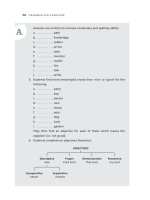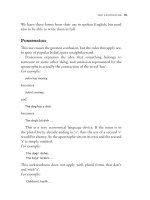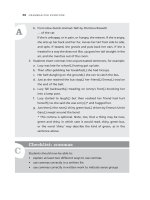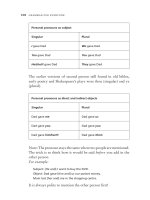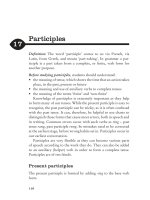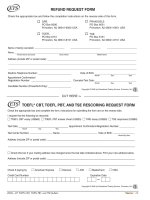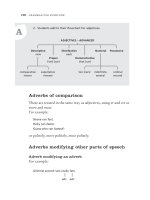Tài liệu Grammar for everyone part 29 pptx
Bạn đang xem bản rút gọn của tài liệu. Xem và tải ngay bản đầy đủ của tài liệu tại đây (119.78 KB, 7 trang )
186
G r A M M A r f o r e V e rY o n e
A
3. Clauses game
A large supply of cards is prepared, approximately 60 per six students.
Students can share in preparing these. More cards will make the
game more fun.
a. Sentences are provided or constructed with the help of the
students. The sentences should not be connected, but each
should include:
a subject consisting of one or more words, for example: My
grandad
a verb: dropped
an object (if applicable): a pile of plates
a clause: when he was helping Grandma
a phrase: in the kitchen
interjections/conjunctions: and, or, but etc
b. The cards are allocated evenly, and each has the name of
a sentence part written at the top. It is a good idea to use a
different coloured pen for each sentence part.
c. The part of a chosen sentence (each one is done separately) that
matches the name of the sentence part is written below.
d. Scores are allocated in order of difficulty, for example: Interjection/
Conjunction 1, subject/object 2, verb 3, phrase 4, clause 5
Example of card
e. When the game is finished, the cards are shuffled into a pack.
Play
Cards are dealt until each student has seven. The remaining pack is
laid face down on the table, with one card upturned beside it.
PHRASE (Adv. Place)
In the kitchen
4
C
A
Aim
Students each try to form a sentence (it must be grammatical, but it
can be nonsense!) by putting together any of the components in their
hands. Once a player has formed a sentence with at least three cards,
he/she may, before their turn, lay the sentence down on the table
where others can see it.
Each player in turn picks up one card from the pack, and discards one
card from his hand, which he puts on the pile facing upwards.
A player may take the card on the top of the facing up pile if he wants
it. If he now has a complete sentence, he must wait for his next turn
before laying it down.
Players may add a card to another’s sentence in order to deplete his
own hand, but he should do this only after he has laid down at least
one sentence of his own.
The game ends when one player has got rid of all his cards.
Scoring
All players add up the numbers printed on the cards they have laid
down. This is their plus score. They must then deduct the total of the
numbers of those cards left in their hand. The winner is the player with
the highest score.
More cards may be added and divided into adjectival or adverbial
phrases or clauses with the category printed on each card. This activity
provides reinforcement.
Checklist: clause analysis
Students should now be able to:
• write all forms of sentence (simple, compound, complex and
compound–complex) grammatically and fluently
• name kinds of clauses
• form clauses of given categories and add to simple sentences
• analyse sentences correctly using one of the formats given
187
c l A u s e A n A lY s i s
188
Word building
It is both interesting and important to give children of any age an
idea about where words have come from, and we can do this at
any time without reference to the grammatical construction of a
word.
When discussing words in relation to spelling and/or compre-
hension, however, students need to be sure of:
• the functions of all parts of speech
• the use of a dictionary for finding out word constructions
Students will become increasingly familiar with the meaning of
specific base words, prefixes and suffixes, as they work with them
in discussion and research. Learning lists of these is of little or no
value.
Words are built from the following:
The base (root) word, which gives the core meaning.
For example:
true (factual)
The prefix, which is added (fix) in front (pre) of the base word to
add to its meaning or modify it in some way, such as making it
negative.
For example:
Base word: true
Prefix: un – not true
The suffix, which is added (fix) after (suf, meaning below) the base
word, and usually indicates the part of speech.
28
For example:
Base word: true (adj)
Suffix: est – truest (adj)
ism – truism (noun)
Base word: ject (throw)
Prefix: in – inject (throw in)
Suffix: ion (noun) – injection (that which is thrown in)
The suffix has important grammatical significance, as it can denote
the part of speech, so enabling comprehension.
While most developed languages have systems of word building,
it is the Latin and Greek languages that have given us most of our
ability to continue adding to English as we require new words for
technical and scientific processes. We also continue to make our
language more subtle and more sophisticated by adding to words
that English has adopted from other languages.
A good dictionary will show the origin of words, together with
the meanings of its various parts. Exercises in finding out how we
have come by some of our words can be fascinating for students
as early as mid-primary. For example, the word ‘companion’
meaning ‘comrade’, is composed of:
Base word: panis (Latin) – bread
Prefix: com – together/with
Suffix: ion – noun form
Hence: com-pan-ion – one you have bread with
As less grammar has been taught in recent decades, and spelling
is often not taught beyond mid-primary, many students are
unaware of the connections between the two which relate chiefly
to word building.
We use the system of word building to convey extra information
of various kinds, by adding word parts to the beginning and end
of base words, i.e. those that carry the core meaning.
For example:
The vet will inject the cow – no suffix, simple verb
The vet injected the cow – suffix ‘ed’, indicating past tense
189
w o r d b u i l d i n G
190
G r A M M A r f o r e V e rY o n e
A
The cow had an injection – suffix ‘ion’, indicating a noun
This medication is injectable – suffix ‘able’, indicates adjective (able to
be)
(See Swallow, G, Word Building, 4th edn 2007, Nutshell Products,
Kalbar, Qld.)
28.1 Activities: word building
1. As examples are written on the board, discuss them with the students
while heading the components as shown:
Prefix Base word Suffix
adds to or modifies meaning core meaning denoting part of speech
re again volve turn/roll er noun
Revolver – the pistol which fires with a revolving action
Hence: revolve, evolve, revolution etc.
2. Students use the following word or word roots, changing the
suffixes to denote different parts of speech.
a. dict (speak)
b. spect (look)
c. volve (turn)
3. Students are given base words from which they list, in a set time, all
the words they can think of that have been built on it, for example:
spect: expect, respect, spectacles etc.
These should be checked with discussion and one or more added to
the chart.
4. Students are given whole words, which they break down and add to
the chart above.
5. Students are given core words to research using a dictionary, for
example:
ostracise, ballot, shampoo, frankincense, dollar
